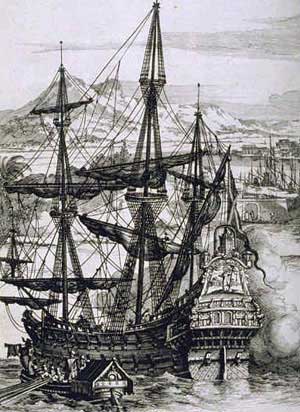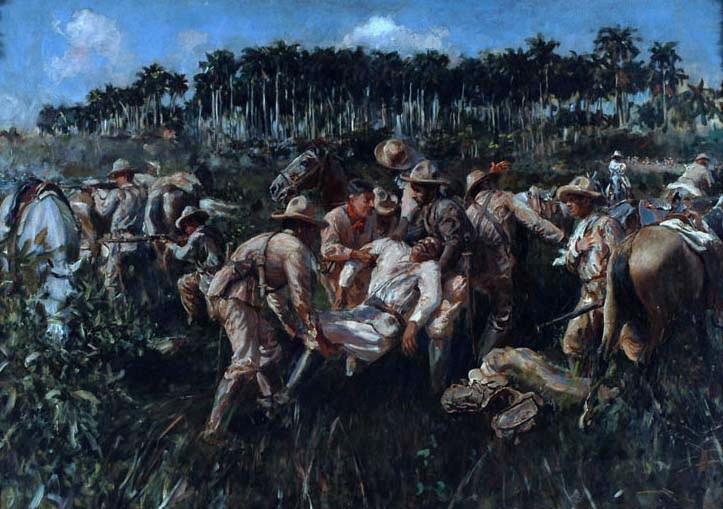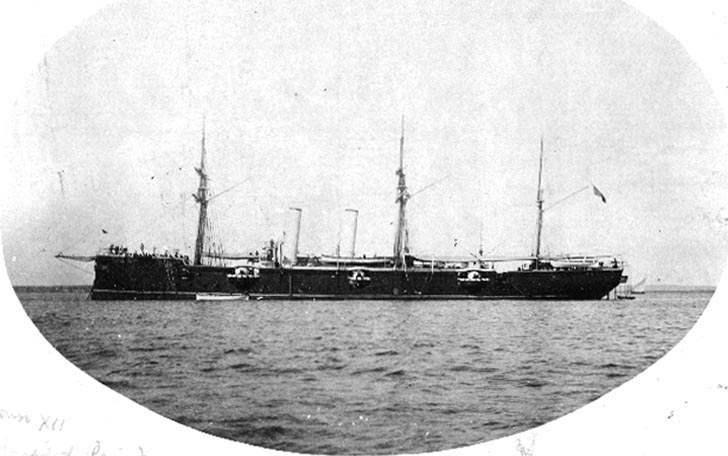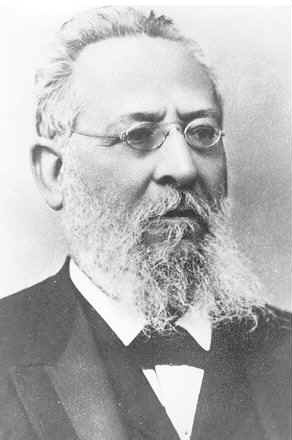|
Remington Rolling Block
Remington Rolling Block is a family of breech-loading rifles that was produced from the mid-1860s into the early 20th century by E. Remington and Sons (later Remington Arms). These rifles were made in a variety of calibers, both rimfire and centerfire, including the 12.17x42 mm rimfire, 12.17x44 mm rimfire and 12.17x44 mm rimmed centerfire Swedish and Norwegian cartridges, .43 Spanish (11.15x58mmR), .50-70, .40-70, .45-70 and later in .22 caliber. Later models were produced in .30-03 (Predecessor to .30-06), 7×57mm Mauser, and 8×50mmR Lebel. Development The Remington Rolling Block was developed from the 1863 pattern .50 calibre split breech carbine issued to the US Cavalry during the American Civil War. This earlier weapon was designed by Joseph Rider and Leonard Geiger to fire the same cartridges as the Spencer carbine. The split breech rifle lacked a hammer spur because it self-cocked when the breechblock was opened. Either 1864 or 1865, Remington Engineer Joseph Ride ... [...More Info...] [...Related Items...] OR: [Wikipedia] [Google] [Baidu] |
Rolling-block
A rolling-block action is a single-shot firearm action where the sealing of the breech is done with a specially shaped breechblock able to rotate on a pin. The breechblock is shaped like a section of a circle. The breechblock is locked into place by the hammer, therefore preventing the cartridge from moving backward at the moment of firing. By cocking the hammer, the breechblock can be rotated freely to reload the breech of the weapon. History The Remington Rolling Block rifle is one of the most successful single-shot weapons ever developed. It is a strong, simple, and very reliable action, that is not prone to be jammed by debris or with rough handling. It was invented by Leonard Geiger during the United States Civil War and patented in 1863, who (along with his partner, Charles Alger) negotiated a royalty deal with Remington when they put it into production as the so-called "split breech" action late in the war. That design was re-engineered by Joseph Rider in 1865 and calle ... [...More Info...] [...Related Items...] OR: [Wikipedia] [Google] [Baidu] |
Anglo-Egyptian War
The British conquest of Egypt, also known as the Anglo-Egyptian War (), occurred in 1882 between Egyptian and Sudanese forces under Ahmed ‘Urabi and the United Kingdom. It ended a nationalist uprising against the Khedive Tewfik Pasha. It established firm British influence over Egypt at the expense of the Egyptians, the French, and the Ottoman Empire, whose already weak authority became nominal. Background In 1881, an Egyptian army officer, Ahmed ‘Urabi (then known in English as Arabi Pasha), mutinied and initiated a coup against Tewfik Pasha, the Khedive of Egypt and Sudan, in order to end Imperial British and French influence over the country. In January 1882 the British and French governments sent a "Joint Note" to the Egyptian government, declaring their recognition of the Khedive's authority. On 20 May, British and French warships arrived off the coast of Alexandria. On 11 June, an anti-Christian riot occurred in Alexandria that killed 50 Europeans. Colonel ‘ ... [...More Info...] [...Related Items...] OR: [Wikipedia] [Google] [Baidu] |
Philippine–American War
The Philippine–American War, known alternatively as the Philippine Insurrection, Filipino–American War, or Tagalog Insurgency, emerged following the conclusion of the Spanish–American War in December 1898 when the United States annexed the Philippine Islands under the Treaty of Paris (1898), Treaty of Paris. Philippine nationalists constituted the First Philippine Republic in January 1899, seven months after signing the Philippine Declaration of Independence. The United States did not recognize either event as legitimate, and tensions escalated until fighting commenced on February 4, 1899, in the Battle of Manila (1899), Battle of Manila. Shortly after being denied a request for an armistice, the Philippine Council of Government issued a proclamation on June 2, 1899, urging the people to continue the war. Philippine forces initially attempted to engage U.S. forces conventionally but transitioned to guerrilla tactics by November 1899. Philippine President Emilio Aguinaldo w ... [...More Info...] [...Related Items...] OR: [Wikipedia] [Google] [Baidu] |
Spanish–American War
The Spanish–American War (April 21 – August 13, 1898) was fought between Restoration (Spain), Spain and the United States in 1898. It began with the sinking of the USS Maine (1889), USS ''Maine'' in Havana Harbor in Cuba, and resulted in the U.S. acquiring sovereignty over Puerto Rico, Guam, and the Philippines, and establishing a protectorate over Cuba. It represented U.S. intervention in the Cuban War of Independence and Philippine Revolution, with the latter later leading to the Philippine–American War. The Spanish–American War brought an end to almost four centuries of Spanish presence in the Americas, Asia, and the Pacific; the United States meanwhile not only became a major world power, but also gained several island possessions spanning the globe, which provoked rancorous debate over the wisdom of expansionism. The 19th century represented a clear decline for the Spanish Empire, while the United States went from a newly founded country to a rising power. In 1895, C ... [...More Info...] [...Related Items...] OR: [Wikipedia] [Google] [Baidu] |
Greco-Turkish War (1897)
The Greco-Turkish War of 1897 or the Ottoman-Greek War of 1897 ( or ), also called the Thirty Days' War and known in Greece as the Black '97 (, ''Mauro '97'') or the Unfortunate War (), was a war fought between the Kingdom of Greece and the Ottoman Empire. Its immediate cause involved the status of the Ottoman Crete, Ottoman province of Crete, whose Greek-majority population had long desired union with Greece. Despite the Ottoman victory on the field, an autonomous Cretan State under Ottoman suzerainty was established the following year (as a result of the intervention of the Great Powers after the war), with Prince George of Greece and Denmark as its first High Commissioner. The war put the military and political personnel of Greece to test in an official open war for the first time since the Greek War of Independence in 1821. For the Ottoman Empire, this was also the first war-effort to test a re-organized military system. The Ottoman Army (1861–1922), Ottoman army operate ... [...More Info...] [...Related Items...] OR: [Wikipedia] [Google] [Baidu] |
Philippine Revolution
The Philippine Revolution ( or ; or ) was a war of independence waged by the revolutionary organization Katipunan against the Spanish Empire from 1896 to 1898. It was the culmination of the 333-year History of the Philippines (1565–1898), colonial rule of Spain in the archipelago. The Captaincy General of the Philippines, Philippines was one of the last major colonies of the Spanish Empire, which had already suffered Spanish American wars of independence, a massive decline in the 1820s. Cuban War of Independence, Cuba rebelled in 1895, and in 1898, the United States Spanish–American War, intervened and the Spanish soon capitulated. In June, Philippine revolutionaries Philippine Declaration of Independence, declared independence. However, it was not recognized by Spain, which sold the islands to the United States in the Treaty of Paris (1898), Treaty of Paris. Led by Andrés Bonifacio, the Katipunan was formed in secrecy in 1892 in the wake of the nascent La Liga Filipina ... [...More Info...] [...Related Items...] OR: [Wikipedia] [Google] [Baidu] |
Intentona De Yauco
The ''Intentona de Yauco'' (''Attempted Coup of Yauco'') of March 24–26, 1897 was the second and final short-lived revolt against Spanish rule in Puerto Rico. It was staged by the pro-independence Revolutionary Committee of Puerto Rico in the southwestern municipality of Yauco, 29 years after the first unsuccessful revolt, known as the '' Grito de Lares'' (''Cry of Lares''). During the ''Intentona de Yauco'', the current flag of Puerto Rico was flown on the island for the first time. The first major revolt in 1868 is known as '' Grito de Lares''. After the failure of this short-lived rebellion, many of the local leaders and participants were arrested, and some were executed. Those who survived their prison terms were later released and some went into exile, especially in New York City. Shortly after the 1868 revolt, Spain gave the island many liberal reforms. It extended to Puerto Rico some elements of the liberal constitution that it had allowed its former colonies in So ... [...More Info...] [...Related Items...] OR: [Wikipedia] [Google] [Baidu] |
Revolution Of 1897
The Revolution of 1897 was an uprising led by the army of the Uruguayan National Party against the government of President Juan Idiarte Borda. It took place in Uruguayan territory between March 5 and September 18, 1897. History The revolutionary movement was led by the Caudillo Aparicio Saravia, and the General Diego Lamas, who arrived at the Banda Oriental Banda Oriental (Eastern Bank), or more fully Banda Oriental del Río Uruguay, was the name of the South American territories east of the Uruguay River and north of Río de la Plata that comprise the modern nation of Uruguay, the modern state of Ri ... from Buenos Aires, together with the so-called "22 de Lamas", among which was Lieutenant Colonel Isabelino Canaveris. On March 17, 1897, took place the Battle of the Tres Arboles (department Río Negro), where the forces of General Diego Lamas defeated the army of Colonel José Villar. One of the causes of the conflict was electoral fraud denounced by leaders of the Nationa ... [...More Info...] [...Related Items...] OR: [Wikipedia] [Google] [Baidu] |
Cuban War Of Independence
The Cuban War of Independence (), also known in Cuba as the Necessary War (), fought from 1895 to 1898, was the last of three liberation wars that Cuba fought against Spain, the other two being the Ten Years' War (1868–1878) and the Little War (1879–1880). During the war, Spain sent 220,285 soldiers to Cuba—according to the Library of Congress, the largest army to cross the Atlantic until World War II. The final three months of the conflict escalated to become the Spanish–American War, with United States forces being deployed in Cuba, Puerto Rico, and the Philippines against Spain. Historians disagree as to the extent that United States officials were motivated to intervene for humanitarian reasons but agree that yellow journalism exaggerated atrocities attributed to Spanish forces against Cuban civilians. Background During the years 1879–1888 of the so-called "Rewarding Truce", lasting for 17 years from the end of the Ten Years' War in 1878, there were fundament ... [...More Info...] [...Related Items...] OR: [Wikipedia] [Google] [Baidu] |
First Melillan Campaign
The First Melillan Campaign, also called the Melilla War or the Margallo War (after Juan García y Margallo, the Spanish governor of Melilla whose defeat and death infuriated the Spanish public) in Spain, was a conflict between Spain and the Riffian tribes of northeastern Morocco, and later the Sultan of Morocco, that began in October 1893, was openly declared November 9, 1893, and was resolved by the Treaty of Fez in 1894. Historical situation The Crown of Castile captured the citadel of Melilla in 1497. In the 19th century Spain moved into the outlying territories and began investing in their economic development. Treaties with Morocco in 1859, 1860, and 1861 consolidated Spain's growing interests. Although Spain enjoyed the compliance of the Moroccan government, tensions flared between Spanish Army patrols and the local Riffian tribes that were hostile to Spain, and over whom the Sultan had practically no control. Riffian raiding and piracy was widely reported in th ... [...More Info...] [...Related Items...] OR: [Wikipedia] [Google] [Baidu] |
Federalist Revolution
The Federalist Revolution (Portuguese language, Portuguese: ''Revolução Federalista'') was a civil war that took place in southern Brazil between 1893 and 1895, fought by the federalists, opponents of Rio Grande do Sul state president, Júlio de Castilhos (politician), Júlio de Castilhos, seeking greater autonomy for the state, decentralization of power by the newly installed First Brazilian Republic. Inspired by the Monarchism in Brazil, monarchist ideologies of Gaspar da Silveira Martins, who had been one of the most prominent politicians by the end of the monarchy and acted as political head of the revolution, the federalists had Gumercindo Saraiva as the military head supported by his brother Aparicio Saraiva, of the Uruguayan National Party (Uruguay), National Party, and by the Revolta da Armada, Navy rebels who, after being defeated at the capital following the Rio de Janeiro Affair, moved south to strengthen the federalist forces. Also known as maragato, ''maragatos'', ... [...More Info...] [...Related Items...] OR: [Wikipedia] [Google] [Baidu] |
Chilean Civil War Of 1891
The Chilean Civil War of 1891 (also known as Revolution of 1891) was a civil war in Chile fought between forces supporting Congress of Chile, Congress and forces supporting the President of Chile, President, José Manuel Balmaceda from 16 January 1891 to 18 September 1891. The war saw a confrontation between the Chilean Army and the Chilean Navy, siding with the president and the congress, respectively. This conflict ended with the defeat of the Chilean Army and the presidential forces, and with President Balmaceda committing suicide as a consequence of the defeat. In Chilean historiography the war marks the end of the Liberal Republic and the beginning of the History of Chile during the Parliamentary Era (1891–1925), Parliamentary Era. Causes The Chilean Civil War grew out of political disagreements between the president of Chile, José Manuel Balmaceda, and the Chilean congress. In 1889, the congress became distinctly hostile to the administration of Balmaceda, and the ... [...More Info...] [...Related Items...] OR: [Wikipedia] [Google] [Baidu] |









